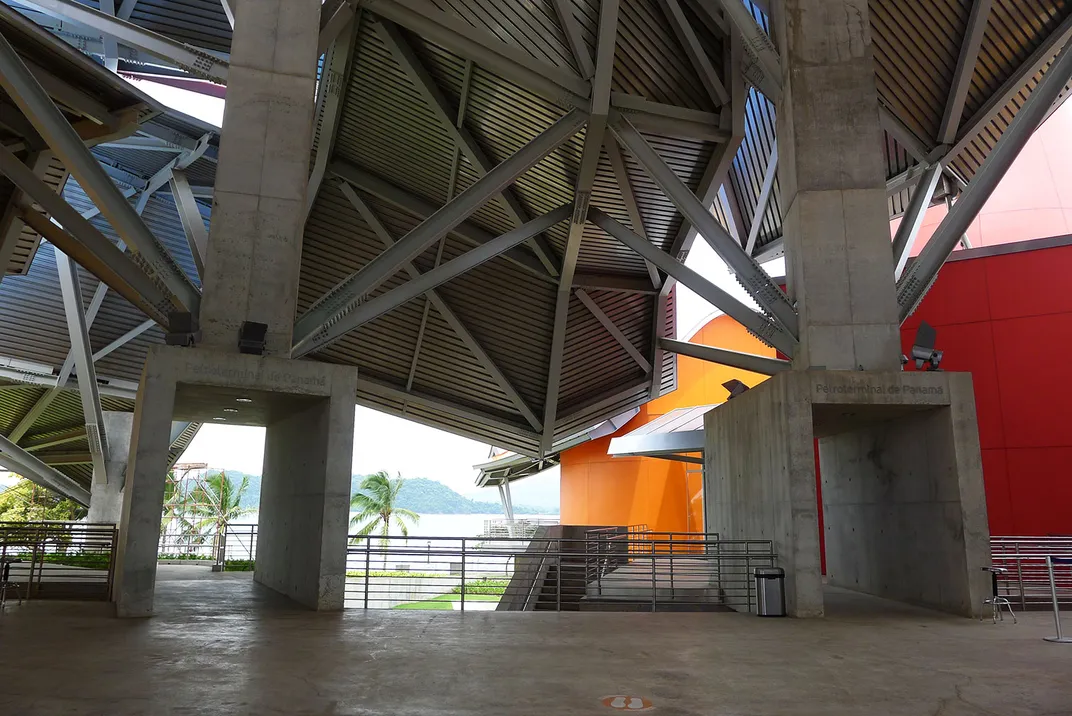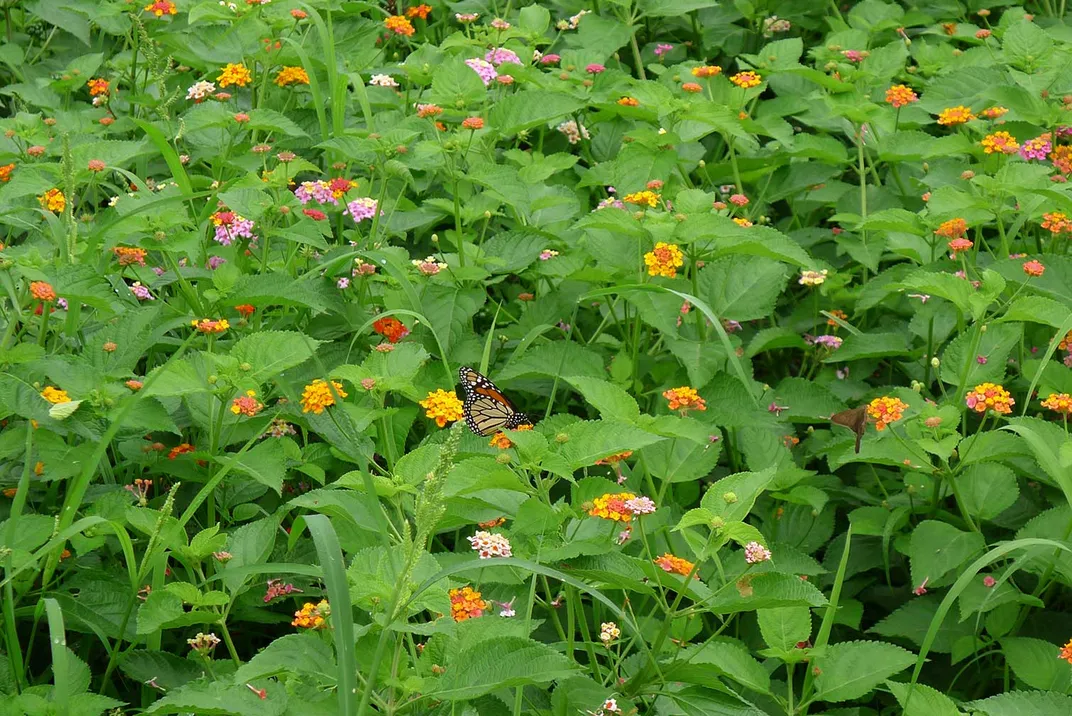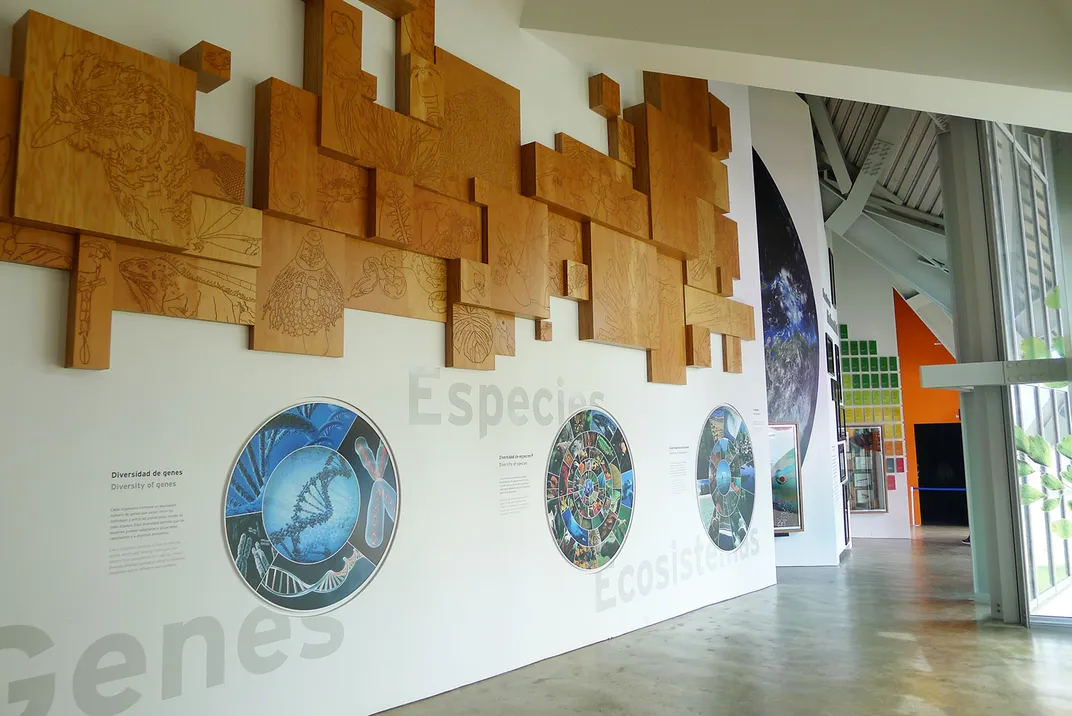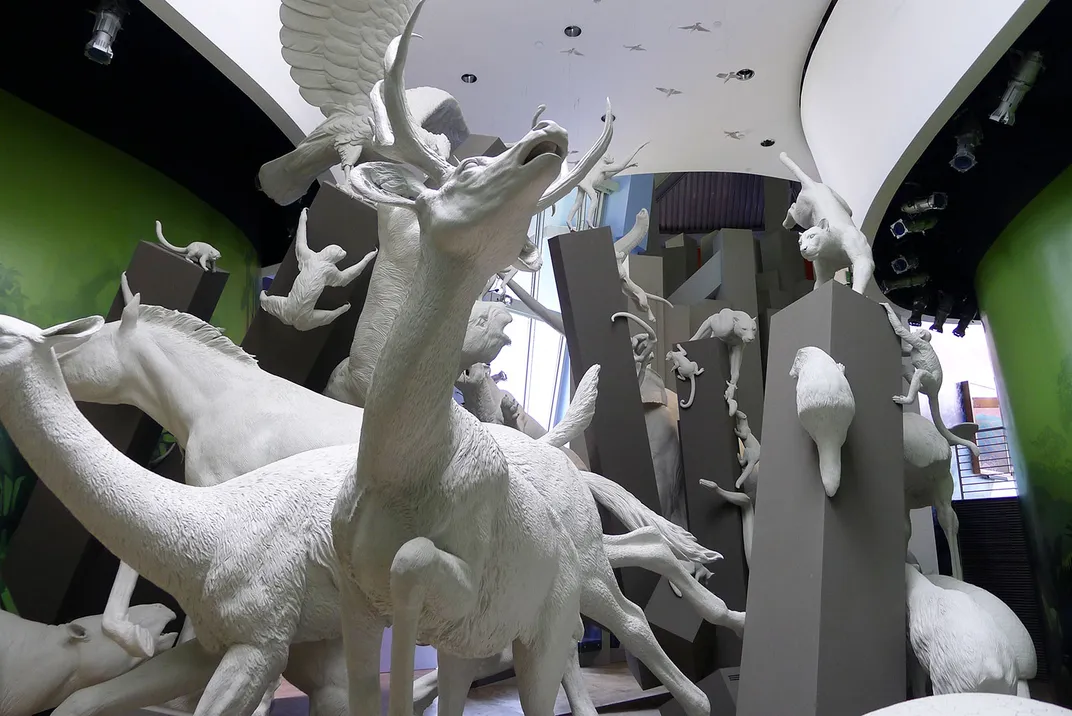Frank Gehry’s Biomuseo in Panama, Finally Open for Business
The eye-popping structure devoted to the nation’s vibrant ecosystems makes its grand debut
/https://tf-cmsv2-smithsonianmag-media.s3.amazonaws.com/filer/18/7e/187ec1c8-ffef-443d-8e32-66a94ccd9f07/biomuseo_amador_panama_city_29-01-2013-71.jpg)
After 15 years of development, ten years of construction, four Panamanian presidential administrations, countless project delays and $100 million dollars spent, Panama’s Biomuseo, designed by famed architect Frank Gehry, is at last open to the public. Slowly but surely, the building, much like the isthmus upon which it is perched, has emerged from nothingness, pushing itself up into being. As I crawl along the Bridge of the Americas in a stream of heavy Saturday morning traffic, it’s impossible not to notice the beast in the distance, with its technicolor shell lazing on the banks of the Canal, basking in the sun.
By late morning, the parking area across from the Biomuseo’s administrative building starts to swell with cars. Families, couples, organized groups large and small, tourists and Panamanians alike converge in an exodus toward the architectural behemoth. There’s an excitement in the air. Butterflies flutter over newly planted lantana flowers. Small saffron finches amuse themselves, intertwined in flight as they nosedive over the fresh sod. The sheer density of playful wildlife gives the scene a Disney-esque vitality. But for Gehry and his team to reach this point, the story has been filled with its share of drama.
At 12:00 p.m. on December 31, 1999, the United States handed full control of the Panama Canal and the surrounding Canal Zone over to the Panama Canal Authority and the Panamanian Government respectively. Over the course of that year, a series of conferences had been held in Panama City in order to determine what should be done with the undeveloped land on either side of the waterway. Gehry’s Panamanian wife, Berta Isabel Aguilera, took part in these discussions. A few years later, her famous architect-husband officially signed on to build a museum on the tourist-friendly Amador Causeway: a collection of four islands that serve as a breakwater at the mouth of the Canal’s Pacific entrance.
Initial public funding for the 43,000 square-foot project was secured in 2001, but it wasn’t until Gehry signed on in 2002 that money really started to pour in. In 2005, he broke ground on the Biomuseo—his first project in Latin America—with a budget of $60 million. Construction was scheduled to be completed by 2011.
Since then, though, construction has been a stop-and-go affair. In 2009, when grocery store tycoon Ricardo Martinelli took the Presidential Office, funding for the project was temporarily interrupted. Shortly after being elected though, Martinelli decided to transfer the loan from private banks to the country's National Bank which made it easier for the project to get going again. Once construction restarted, however, many of the workers who had been carefully trained in special skills to work on Gehry’s challenging design had been poached by high-paying corporate contractors. Scores of new workmen had to be hired and trained.
By 2012, the steady stream of funding had slowed to a trickle. Now $40 million over budget, the project had become a point of contention among politicians and investors alike. "Although it's taken longer than we would like, with many more challenges than expected, the project still embodies the ideals we initially envisioned," Anand Devarajan, the architect at Gehry Partners overseeing the project, told LA Weekly last month.
I met Margot López beneath the flamboyant multi-panel roof of the museum. López is the communications coordinator for the Biomuseo and has been working with the project for over six years now. I met Lopez almost two years ago when I took a hardhat tour of the museum construction site. I’m happy to see that she’s still here. We stand in the open-air lobby and appreciate the almost 360-degree view surrounding us: to our right, barely a hundred feet away, hulking cargo ships lurk past in the canal waters on their way to the Mira Flores Locks; straight ahead the causeway continues to narrow as it reaches for the Pacific; and to the left sits the glassy Bay of Panama and, just beyond, the shimmering metropolis of Panama City, slightly hazy in the near distance.
The museum, a Smithsonian affiliate, is heavily staffed. Employees and guides are casually dressed in jeans and black polo shirts. They have walkie-talkies and headsets. Other than a few lingering scaffolds, things seem pretty much ready. As they prepare for their official opening and inauguration ceremony on October 2, the troupe appears to be in a state of general fluffing and primping—making the most of the three months of soft opening.
Visitors must begin at the Gallery of Biodiversity which acts as an introduction to Panama’s genetic, ecological and biological bounty. Colorful placards on the wall display names, both in Spanish and English, of critically endangered Panamanian species, including the hawksbill turtle, alongside extinct species like the spiny green tree frog and the splendid poison frog. Also covered in this gallery are the current bio-prospecting initiatives that are being carried out in the country by organizations such as the Smithsonian Tropical Research Institute (STRI).
Next up is the vertigo-inducing Panamarama exhibit where visitors are practically surrounded by ten gigantic projection screens, underfoot and overhead, some as high as 30 feet in the air, and battered for six glorious minutes with recorded images and sounds of Panama’s natural wonders. After leaving the Panamarama gallery with a slight kink in the neck, visitors are introduced to the geological history of the isthmus. Towering tectonic sculptures reach like blades of grass to the ceiling and ancient rocks from various regions of Panama loom below. The gallery aims to introduce visitors to the rather dramatic geological formation of the isthmus over the last few million years. On display is a 70-million-year-old pillow basalt from Punta San Lorenzo and 6-million-year-old sandstone dredged up from Toro Point in Colon with mollusk fossils, barnacle plates and sea urchin fragments embedded in the rock.
The flow through the different exhibits is quite strict, as if on rails. Dilly-dallyers who prefer a more freeform museum-going experience might be disappointed by the narrow hallways of most of the galleries and the pressure to keep moving through. But the conceptual approach taken by Bruce Mau Design, the firm responsible for the internal design of the structure, is clearly intentional. George Angehr, a research associate at STRI who is also the curator of exhibitions for the museum says via e-mail that “the Biomuseo is designed as a narrative of how Panama's geological, biological and human history has created its great biodiversity.”
Around the corner, 97 animals are suspended in an elaborate, never-ending tableau representing the cross-migration that took place once the isthmus of Panama rose from the deep to create a land bridge between North and South America some 3 million years ago. Fantastic creatures that challenge the imagination of even the most educated visitor have been carved out of fiberglass and covered with a stark-white epoxy making them durable enough to allow touching—that elusive tactile privilege that museums of old frowned upon is encouraged at the Biomuseo. For instance, a child could, if he or she were so inclined, scale the three-foot tank-like shell of a long-extinct Texas glyptodont and pretend to ride the armadillo-like creature as if it were a bucking bronco. Or a young couple could nuzzle together in the formidable bosom of a hermit ground sloth as it stands on its hind legs and reaches almost 13 feet into the air foraging for leaves. (Remains of this titanic bear-like sloth have been discovered in Panama’s Azuero peninsula.)
Continuing along the trail through the galleries, visitors are then ushered out into an open-air exhibit detailing the arrival of civilization on the isthmus—an event that took place more than 15,000 years ago. The Human Path, as the exhibit is named, is actually free for those who don’t want to fork over the price of admission (Residents: $12 USD /adult, $6/child; Non-Residents: $22/adult, $11/child). Much of the property is actually part of this free-to-use zone including a frog pond, outdoor classrooms and gardens.
Gehry and his team may already be $100 million deep but they still have a ways to go before the Biomuseo is fully operational. Another $15 million in funding is needed to complete the three remaining galleries. The most expensive of which—an ambitious two-story aquatic exhibit called Oceans Divided—may not be completed until 2016. The construction of these final spaces has been drawn out for so long that the exhibit design has been updated since its original conception to incorporate recently developed interactivity technology. López tells me about the new plan to have wall-mounted screens that will display dynamic content based on information that each visitor took a particular interest in during their safari through the museum.
“Down the line, the museum will have an economic impact,” says Pilar Arosemena de Alemán, the current president of Fundación Amador, the foundation behind the project. “And it will be a source of pride. It will show that we Panamanians can build—and can have a project—with world standards.” For an example of the sort of economic impact one of Gehry’s buildings can have on a city, one needs to look no further than Bilbao, Spain. In 1997, the Guggenheim Bilbao, an ambitious $89 million modern and contemporary art museum, opened as part of a revitalization effort for the city. In the first three years of operation, almost four million tourists visited The Guggenheim Bilbao and generated over €500 million in economic activity. “Given its unique design and placement at the crossroads of the world,” Angehr says, “the Biomuseo has the potential to become as iconic for Panama as the Sydney Opera House has been for Australia.”
Whether Gehry’s $100 million Biomuseo will generate the same cornucopia of revenue for Panama that his Guggenheim did for Spain remains to be seen. His track record is far from spotless. The visionary has built a few white elephants in his time including the Royal Ontario Museum in Toronto, which made headlines for injuring passersby when snow and sheets of ice came sliding off the angular roof panels in the dead of winter. And the $300 million Stata Center in Cambridge, Massachusetts, which was the subject of a 2007 lawsuit filed by M.I.T. citing pervasive leaks, cracks and drainage problems.
A sizeable chunk of the project’s budget, however, has been put toward an education program that integrates lessons on the country’s biodiversity into the Panamanian curriculum. Students will go on multiple field trips to the museum each year. “The Biomuseo is intended to be a place to foster connections,” Angehr says, “as a gateway to connect Panama to the rest of the world, and within Panama to connect Panamanians and visitors to the rest of their country and to inform them of the important global role it has played.” The museum itself has two full-time teachers on staff. This admirable commitment to knowledge seems to permeate everything the museum does. But, more importantly, it doesn’t ruin the fun. The experience is decidedly half school, half schoolyard.
Some call it post modern genius. Others call it a flaming pile of garbage. Gizmodo’s Geoff Manaugh recently described the building as “utterly god awful.” I’m sure Gehry’s heard it all before. One thing is for sure: at almost $3,000 per square foot, his Biomuseo is quite possibly the most expensive ode to nature ever constructed.
Editor's note, September 12, 2014: This story has been edited to clarify the level of support for the Biomuseo provided by the Panamanian government.




